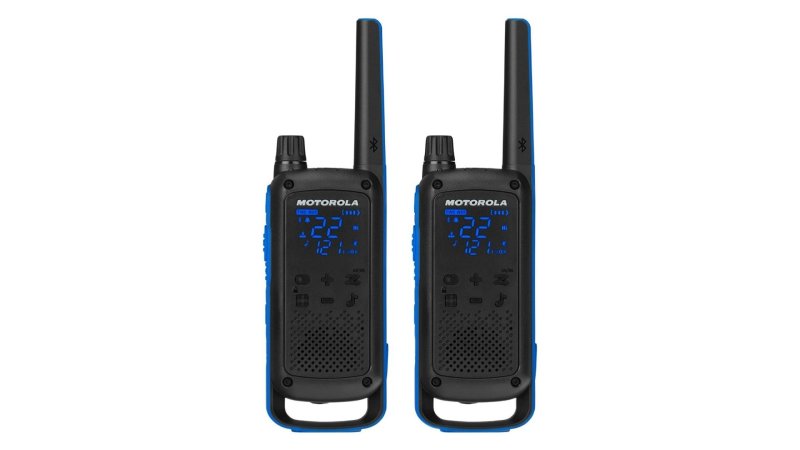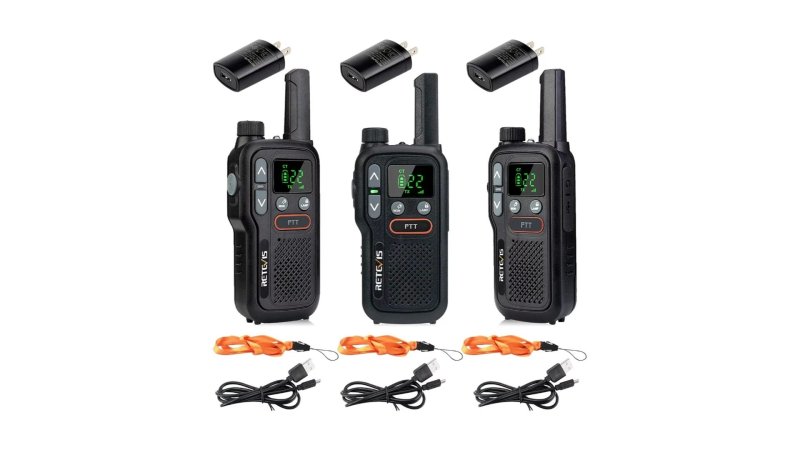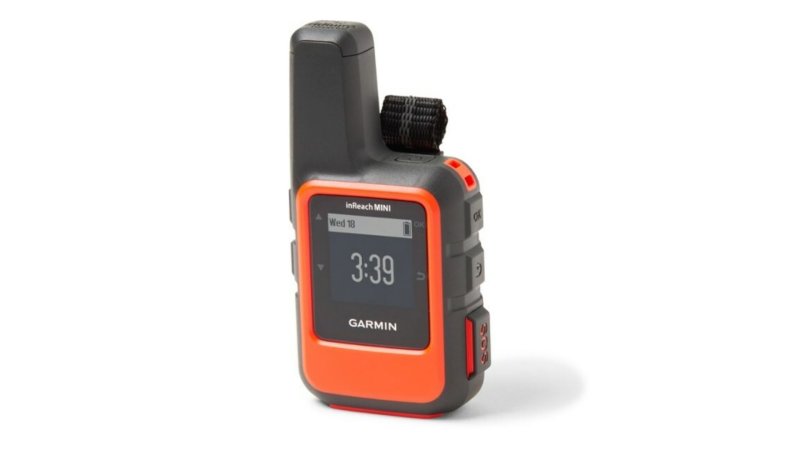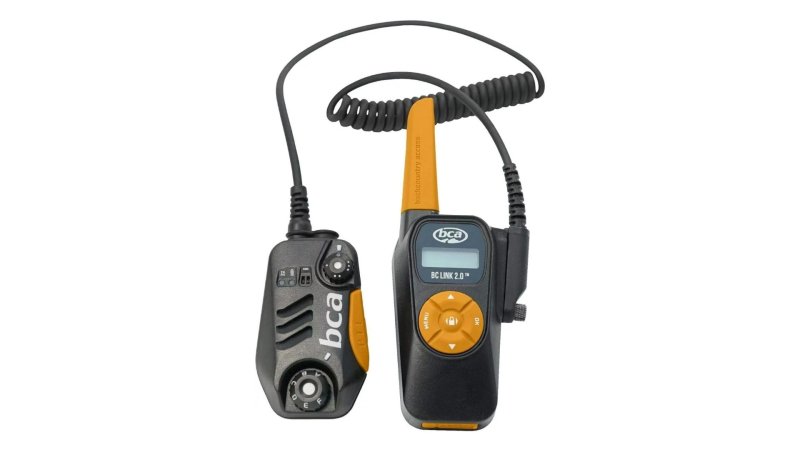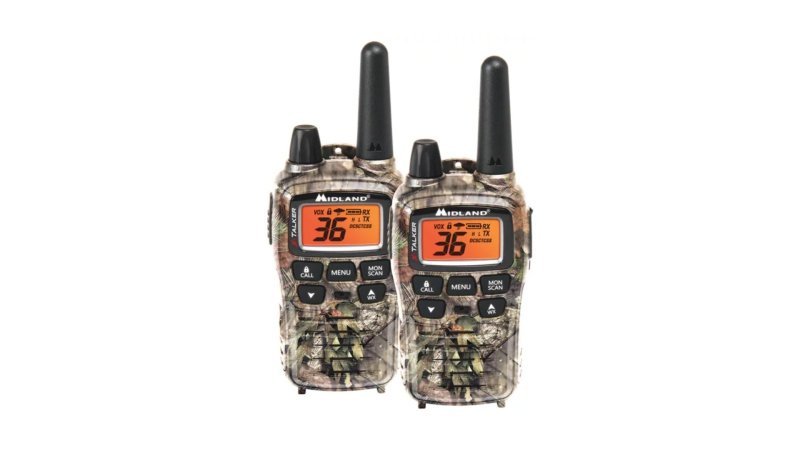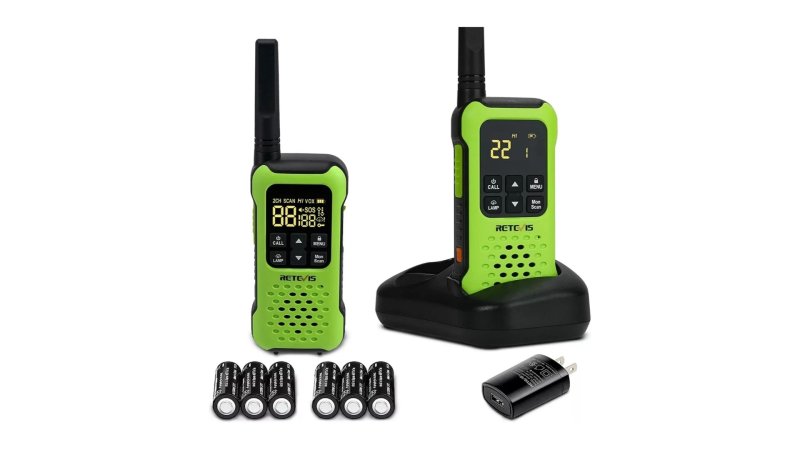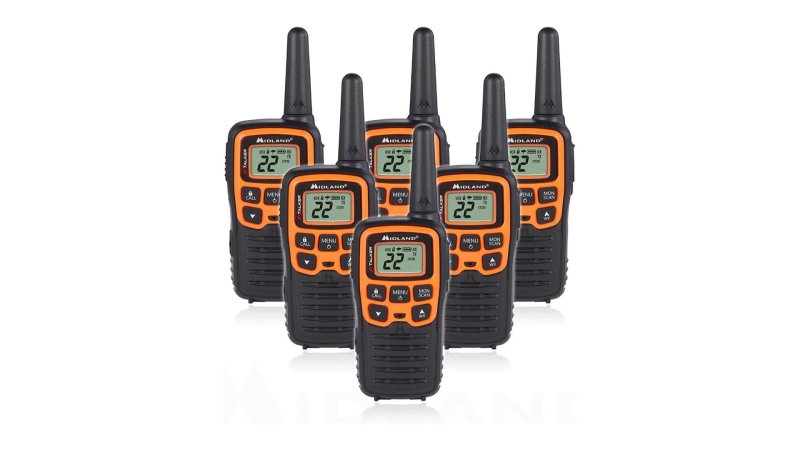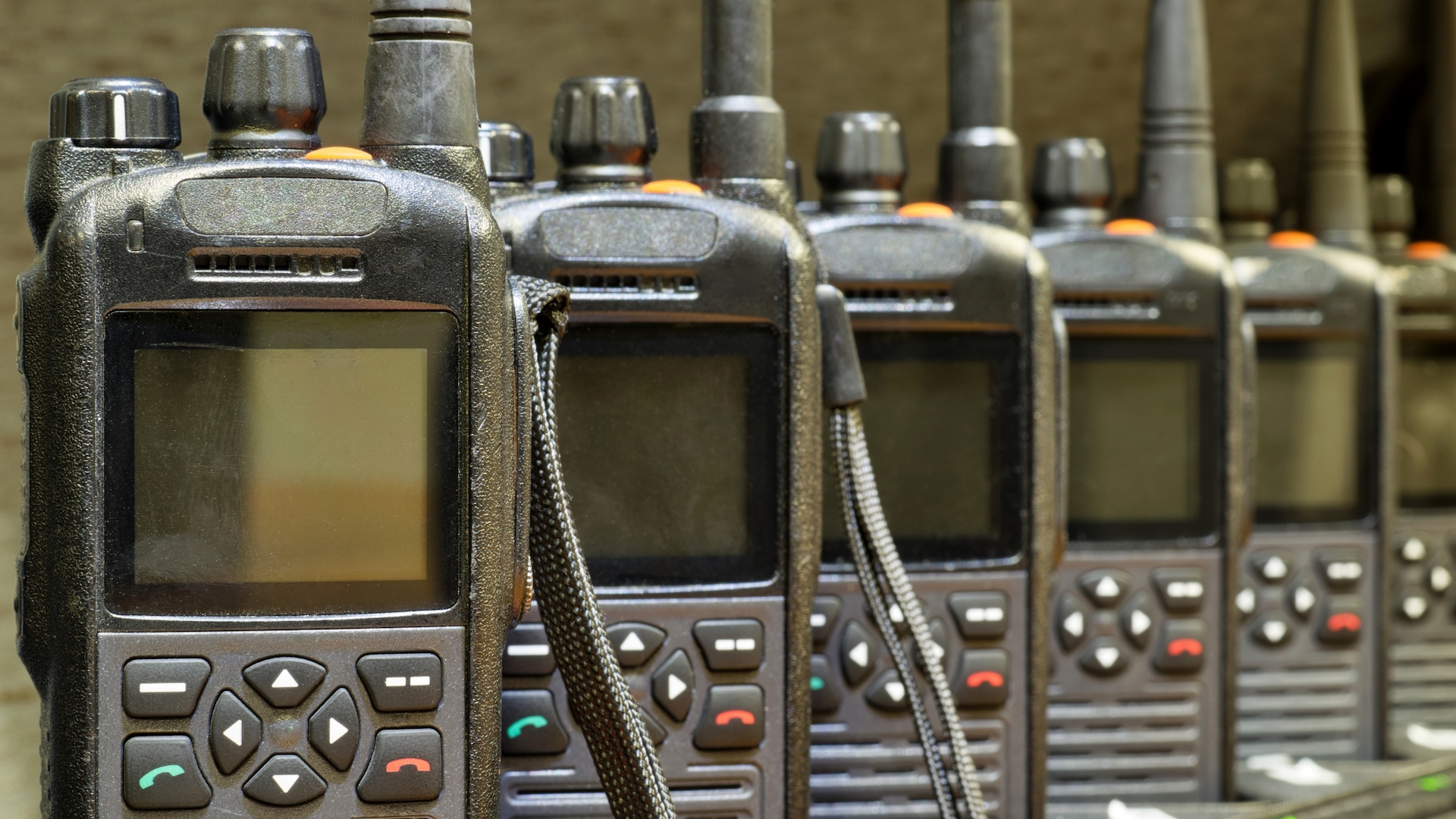

We may earn revenue from the products available on this page and participate in affiliate programs.
If your primary reason for shopping for the best walkie talkies is to have an excuse to use callsigns, I can’t blame you. I remember when my buddy and I convinced our Marines that there was a NATO formula used to determine callsigns we had given them, like “frosting,” “sprinkles,” and “albatross.”
Of course, there are other reasons to look for the best walkie talkies beyond making up games for yourself and your friends. They’re a huge asset in emergency situations that knock out phone lines and cell service, but they’re also really helpful when you’re traveling in a group, whether you’re hiking a mountain or road-tripping in a convoy across the country.
The good news is that there are a lot of great options, and they don’t cost a whole lot. If you have some room in your budget, you can up your game with beefy radios that pack all kinds of tech like text messaging and GPS navigation. We picked some of the best the market has to offer for this gear guide and found some great background information to help you make an informed purchase. Over.
Best Overall
Motorola Talkabout T800
Pros
- Texting and vibration alerts provide silent communication
- Capable of location sharing off-grid
- Huge selection of privacy codes
- Can be used with a rechargeable battery or disposable batteries
Cons
- Claimed range is optimistic in real-world environments
- Talkabout app is nice but could be better
- IPX4 waterproof rating is underwhelming at this price
Product Specs
- Service: FRS
- Transmission power: Two watts
- Channels: 23
- NOAA alerts: Yes
Best Value
Retevis RB18
Pros
- Three chargers are included, one for each radio
- Voice activation included with nine sensitivity settings
- Built-in flashlight is a nice backup for emergency use
- NOAA weather alerts keep you in the loop
Cons
- Construction is fine, but not exactly rugged
- Battery life has only 14 hours of use
- Disposable batteries cannot be used as a backup
Product Specs
- Service: FRS
- Transmission power: Two watts
- Channels: 22
- NOAA alerts: Yes
Editor’s Choice
Garmin inReach Mini
Pros
- Unlimited range and global service
- GPS navigation is included and accurate to five meters
- SOS feature summons help via automatic distress signal
- Lasts 50 hours on one charge
Cons
- Restricted to communicating with compatible devices
- Costly to buy and requires a monthly subscription
- Navigation is good but the screen is very basic
Product Specs
- Service: Satellite
- Transmission power: Not applicable
- Channels: Not applicable
- NOAA alerts: No
Best Heavy-Duty
Backcountry Access BC Link 2.0
Pros
- Incredibly rugged and built to take a beating
- Extremely long battery life
- Extra set of controls on the handset
- Includes 22 channels, each with 121 security codes
Cons
- Price is not for the faint of heart
- Relatively basic tech features and capabilities
- Larger and heavier than most walkie talkies
Product Specs
- Service: FRS
- Transmission power: Two watts
- Channels: 22
- NOAA alerts: No
Best for Hunting
Midland T75 VP3 X-Talker
Pros
- Camouflage and silent mode keep this radio under the radar
- Includes five animal call tones
- Battery packs charge in three hours and last several days
- Weather alerts keep you ahead of the storm
Cons
- Text messaging would be really nice on a hunting radio
- No room for aftermarket customization
- Line-of-sight radios have limited range in dense vegetation
Product Specs
- Service: FRS
- Transmission power: Two watts
- Channels: 36
- NOAA alerts: Yes
Best Waterproof
Retevis RT49P
Pros
- Floats so you won’t lose it
- Waterproof so you won’t destroy it
- NOAA alerts available on 11 weather channels
- Digital display keeps all information in one place
Cons
- Battery life is very limited at eight hours in use
- Display can be hard to read in bright sunlight
- Heavier batteries may compromise the ability to float
Product Specs
- Service: FRS
- Transmission power: Two watts
- Channels: 22
- NOAA alerts: Yes
Best for Emergencies
Midland T51 VP3
Pros
- Affordable way to outfit the whole family
- Each radio only requires one AA battery
- Weather alerts give you time to prepare
- Small and light enough to grab and go
Cons
- Battery life is limited
- Limited range means everyone needs to stay close
- Cannot be paired with other devices for more capabilities
Product Specs
- Service: FRS
- Transmission power: Two watts
- Channels: 22
- NOAA alerts: Yes
Why you should trust us
After my time in the Marine Corps, I know that maintaining reliable communication is serious business. It matters when you’re using a PRC-152 overseas and it matters when you’re keeping tabs on the kids during a camping trip. We’ve made sure to bring you the best gear recommendations for everything from shit-hits-the-fan survival gear to tactically acquiring a slice of pizza. If a product doesn’t make us personally want to use it, it doesn’t get anywhere near our gear guides. Every radio on this list has earned not only our confidence, but the trust of thousands of owners who use them, abuse them, and sing their praises on radio forums all over the internet.
Types of walkie talkies
Walkie talkie can take on a few different meanings, but it’s important to know what you’re talking about before you buy a set of radios and hit the push-to-talk button for the first time. First and foremost, you need to know that the radios you buy can do what you need them to do. Second, it’s a good idea to make sure you won’t be incurring the wrath of the feds. Don’t worry, we have your back.
Citizen’s band
Citizen’s band radios are hugely popular with truckers because of their respectable range (anywhere from three to 20 miles, depending on the radio and environment) and low cost. Both of these advantages come courtesy of CB radio’s reliance on AM frequencies. No license is required, but FCC rules and stubborn Texas lawmen still apply.
These radios are larger than a walkie talkie, so they’re best suited to use in a building or vehicle. One of the advantages is the ability to purchase components separately, so you can choose the radio, handset, and antenna that work best for you. If you spend a lot of time on the road, a CB radio can be a solid alternative to a walkie talkie.
Family Radio Service (FRS)
When most people talk about walkie talkies, they’re referring to radios that operate on frequencies reserved for the family radio service. Easy access to radio communication was in jeopardy at one point, and we owe a debt of gratitude to Radio Shack for stepping in and convincing the federal government to protect certain wavelengths for the general public.
These FRS radios have limited range and strength of signal because their transmitting power cannot exceed two watts, but they’re inexpensive and easy to use. They’ve become increasingly popular over the years with people who enjoy spending time in the outdoors and families who want to stay in touch on the go. We focused on FRS radios for this list, since they don’t require any kind of license or training to operate and come ready to rock out of the box.
General mobile radio service
Like the FRS band, general mobile radio service uses FM radio to communicate. This results in signal quality that’s much stronger and clearer than what you’d get from a CB radio. The difference between FRS and GMRS lies in power output. Stepping up to a GMRS radio will get you access to a better signal, increased range, and less chatter from other users.
The downside of GMRS radios is that they’re subject to more government regulation. Users need to be licensed to operate on these frequencies. Licensure isn’t expensive, but it’s an extra step that isn’t necessary for most people and (shocker) it’s unnecessarily complicated.
Amateur radio
Amateur radios sound like the easiest option for new users, but the name is a little misleading. This “ham” designation isn’t aimed at new users who want to chat while they hunt, hike, or ski; it’s for enthusiasts who want to learn the ins and outs of how radios work.
Tampering with your radios is frowned upon and may get you in hot water with the authorities — unless you have a ham radio license. In fact, licensed radio operators are encouraged to tinker with their equipment and experiment with getting the most out of it. These radios are far more powerful than anything else on this list, and are capable of achieving tremendous range.
Key features of walkie talkies
Reliability
If it ain’t broke, don’t fix it. The old adage about keeping things simple definitely appies to walkie talkies. Cellular service gets better every day, but it still has massive blind spots in parts of the country where people like to enjoy the outdoors. Our phones are also vulnerable to service outages that can leave hige segments of the population in the dark.
Walkie talkies don’t have this problem because they create their own network and have their own power source. As long as you have a charged battery and reasonably clear environment, you can establish communications with an inexpensive set of radios. The downside is range––most walkie talkies tap out after a mile. That’s better than nothing, though, and it’ll do the trick most of the time.
Texting
Manufacturers are packing all kinds of innovative features into newer radios, including the ability to send information via text. Coverage for this kind of service is much better than cellular service, and it’s extremely reliable. Radios can even send packaged information including a user’s GPS location, speed, and type of broadcast station.
Text communication between radios can be limited to a few preprogrammed messages, or it can allow you to type out custom messages. Some radios can even reach people via email. This capability is a big advantage in situations where noise discipline is important or audio communication is compromised. Radios with this capability might require a radio license.
GPS
Most people who use walkie talkies also have a use for a GPS device. Manufacturers like Garmin are killing two birds with one stone by offering walkie talkies that include GPS and a digital map. This might be more than most people need, but if your style of adventure takes you far off the beaten path, this is the way to go.
These radios aren’t cheap, but they beat carrying separate devices, and build quality tends to be excellent. Entry-level options offer two-way communication and basic navigation capability, while the very best feature large, full-color displays and advanced navigational aids.
Benefits of walkie talkies
Emergency preparedness
Most people probably buy walkie talkies with a “just in case” mindset. These little devices provide peace of mind because they can still function when other modes of communication fail. During a natural disaster or outdoor mishap, they can deliver life-saving messages when cell phones and computers fail.
If this is your rationale for buying a set of walkie talkies, think about the situations that would require you to use them. Opting for a waterproof option isn’t a bad idea. You’ll probably want more than two. Stage radios in multiple places, so each member of your family or group can get to one easily and quickly if something goes wrong. And, of course, keep them charged at all times.
Ready to road trip
Those of us who love a good road trip can definitely benefit from a good walkie talkie. CB radios are still the king of the road when it comes to reaching other drivers, but a simple walkie talkie can get the trick done, too.
Compared to cell phones, radios do a much better job of keeping our eyes on the road. They also have longer battery life and don’t burn up your data. Less powerful radios sometimes struggle to penetrate a vehicle’s sheet metal, though, so keep that in mind if road trips are a priority for you. You’ll also need to stay within about a mile of other members in your group.
Built for the outdoors
As capable as cell phones are, they aren’t built to take very much abuse. Call it bravery if you want, but we think pulling out your $1,000 phone to make a call from a canoe sounds like a really bad idea. Better tuck that thing away for safekeeping.
Walkie talkies are far simpler, more durable, and may even be waterproof and float. They do everything you need them to do when you’re out camping, backpacking, hunting, or otherwise exploring the great outdoors. They’re also relatively inexpensive, so you don’t have to baby them. Some even come with GPS capability, so you can navigate and communicate using one device.
Pricing considerations of walkie talkies
Entry-level
Entry-level walkie talkies cost less than $30 for a pair and can be a real hit-or-miss proposition. On one hand, FRS radios are basic enough that good ones really don’t cost very much to produce. On the other hand, there are plenty of manufacturers who will happily sell you a toy that’s of little use in the real world.
We found some very cost-effective options, including one three-pack for less than $40 that averages out to land in this category. It’s basic, sure, but it can still get the job done as long as you understand its limitations and don’t stray too far.
Mid-range
This is a pretty broad range, between $30 and $100, and it’s where you’ll find the majority of radios we recommend. Walkie Talkies in this category will have a usable degree of durability and some mix of specialized features like waterproofing, Bluetooth, or other activity-specific capabilities.
All FRS radios are capped at two watts of transmitting power by the FCC, so range is pretty uniform across makes and models. Differences in price are a result of build quality and added features. The good news is that, no matter what your needs are, there’s a good chance your next walkie talkie costs less than $100.
Premium
Once you break the $100 mark, a lot of really nice features become available. Not only do walkie talkies in this price range come chock-full of channels, privacy codes, and other tech, they’re durable and backed by some of the leading names in the communication business.
This is where you’ll find the types of radios used by backcountry guides and extreme athletes. It’s also where you can get your hands on the latest technology, like satellite networks that connect devices anywhere in the world. Prices can go well beyond $100. We included one option that breaks the $300 barrier so, if this is what you want, bring a few bills along for the ride.
How we chose our top picks
Our goal for this gear guide was to showcase the best walkie talkies that are ready to go out of the box with no specialized training or licensing. Sure, GMRS and ham radios will blow these little FRS walkie talkies out of the water in terms of performance, but they’re also subject to government regulations and can require specialized knowledge to operate effectively. Beyond that, we weeded out radios with spotty ownership experience to make sure we only presented quality products with track records of success.
FAQs about walkie talkies
You’ve got questions, Task & Purpose has answers.
Q. How much range do I need?
A: The useable range of most walkie talkies is pretty limited––typically less than a mile. It’s possible to get better results, but going much further requires a license. Becoming a licensed radio operator isn’t expensive and it opens the doors to higher quality radios.
Q. What features do I need to consider when buying a walkie-talkie?
A: Which walkie talkie you choose depends on what you plan to use it for. Some things to consider are waterproofing, texting, GPS capabilities, and the number of channels your radio comes programmed with.
Q. What’s the difference between VHF and UHF radios?
A: Radio frequencies are classified by their wavelength. VHF (very high frequency) radios use wavelengths between 30 and 300 megahertz and are useful in unobstructed outdoor settings. UHF (ultra-high frequency) radios operate between 300 and 3,000 megahertz and provide a higher quality signal.
Q. How much do walkie talkies cost?
A: Most FRS radios, like those on this list, cost less than $100. Entry-level sets can be found for less than $40 and premium ones can go for nearly $200. The latest and greatest cost even more than that.
